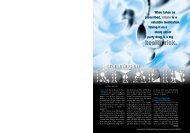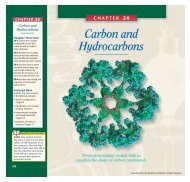You also want an ePaper? Increase the reach of your titles
YUMPU automatically turns print PDFs into web optimized ePapers that Google loves.
Chapter 9<br />
Summary<br />
Teaching Tip<br />
Ask students to prepare a concept<br />
map of the chapter. The concept<br />
map should include most of the<br />
vocabulary terms, along <strong>with</strong><br />
other integral terms or concepts.<br />
342<br />
KEY TERMS<br />
buoyant force (p. 319)<br />
fluid (p. 318)<br />
ideal fluid (p. 332)<br />
mass density (p. 319)<br />
pressure (p. 325)<br />
temperature (p. 331)<br />
342<br />
Chapter 9<br />
CHAPTER 9<br />
Summary<br />
KEY IDEAS<br />
Section 9-1 <strong>Fluid</strong>s and buoyant force<br />
• A fluid is a material that can flow, and thus it has no definite shape. Both<br />
gases and liquids are fluids.<br />
• Buoyant force is an upward force exerted by a fluid on an object floating<br />
on or submerged in the fluid.<br />
• The magnitude of a buoyant force for a submerged object is determined<br />
by Archimedes’ principle and is equal to the weight of the displaced fluid.<br />
Section 9-2 <strong>Fluid</strong> pressure and temperature<br />
• Pressure is a measure of how much force is exerted over a given area.<br />
• The pressure in a fluid increases <strong>with</strong> depth.<br />
Section 9-3 <strong>Fluid</strong>s in motion<br />
• Moving fluids can exhibit laminar (smooth) flow or turbulent flow.<br />
• An ideal fluid is incompressible, nonviscous, and nonturbulent.<br />
• According to the continuity equation, the amount of fluid leaving a pipe<br />
during some time interval equals the amount entering the pipe during<br />
that same time interval.<br />
• According to Bernoulli’s principle, swift-moving fluids exert less pressure<br />
than slower-moving fluids.<br />
Section 9-4 Properties of gases<br />
• An ideal gas obeys the ideal gas law. The ideal gas law relates the volume, pressure,<br />
and temperature of a gas confined to a container.<br />
Variable symbols<br />
Quantities Units Conversions<br />
r density kg/m 3<br />
kilogram per = 10 –3 g/cm 3<br />
meter 3<br />
P pressure Pa pascal = N/m 2<br />
= 10 −5 atm<br />
T temperature K kelvin<br />
°C degrees Celsius = K − 273<br />
k B Boltzmann’s constant J/K joules per kelvin<br />
Copyright © by Holt, Rinehart and Winston. All rights reserved.
















